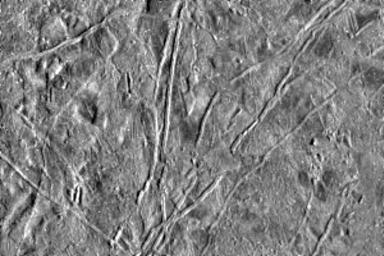
|
Flows on Europa
- Click the image above for a larger view
- Full-Res JPEG (1200 x 800) (124.0 kB)
- Full-Res TIFF (1200 x 800) (1.0 MB)
Caption:
The icy surface of Europa, one of the moons of Jupiter, was photographed by the Galileo spacecraft on its fourth orbit around Jupiter. The area shown here is about 77 miles (124 kilometers) by 115 miles (186 kilometers) across and shows features as small as a half a mile (800 meters) across. Thick, lobate flows, the first seen on Europa or any of the icy satellites of Jupiter, are visible in several areas, including the lower right quarter of the picture where one flow cuts across a prominent ridge. Most of the ridges on the left side of the picture appear to be partly buried or subdued by flows. The ice-rich surface of Europa suggests that the flows might also be ice, perhaps erupted onto the surface from the interior as viscous, glacierlike masses.
This picture was taken by the solid state imaging television camera on board the Galileo spacecraft at a distance of 39,191 miles (63,490 kilometers). The picture is centered at 319.5 degrees West, 5.11 degrees North; north is toward the top of the image with the sun shining from the right to the left.
Background Info:
The Jet Propulsion Laboratory, Pasadena, CA manages the mission for NASA's Office of Space Science, Washington, DC.
This image and other images and data received from Galileo are posted on the Galileo mission home page on the World Wide Web at http://galileo.jpl.nasa.gov. Background information and educational context for the images can be found at http://www.jpl.nasa.gov/galileo/sepo .
Cataloging Keywords:
| Name | Value | Additional Values |
|---|---|---|
| Target | Europa | Jupiter |
| System | Jupiter | |
| Target Type | Satellite | Planet |
| Mission | Galileo | |
| Instrument Host | Galileo Orbiter | |
| Host Type | Orbiter | |
| Instrument | Solid-State Imaging (SSI) | |
| Detector | ||
| Extra Keywords | Grayscale | |
| Acquisition Date | ||
| Release Date | 1998-03-06 | |
| Date in Caption | ||
| Image Credit | NASA/JPL | |
| Source | photojournal.jpl.nasa.gov/catalog/PIA00540 | |
| Identifier | PIA00540 | |
